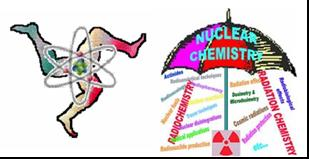Prof.
Amares Chatt
(SLOWPOKE-2 Facility, Trace Analysis Research Centre, Department of Chemistry, Dalhousie University, Halifax, NS, B3H 4J3, Canada)
23/09/2011, 11:00
Radioanalytical Chemistry and Nanoparticles
oral presentation
Simultaneous speciation neutron activation analysis (SSNAA) technique is being developed in our laboratory over the last 20 years or so. This technique can be reliably used for the simultaneous determination of not only various species of a single element but also species of other elements present in the same sample. Almost all speciation techniques consist of two steps. The first step...
Prof.
Jan Kucera
(Nuclear Physics Institute ASCR, Rez, Czech Republic)
23/09/2011, 11:20
Radioanalytical Chemistry and Nanoparticles
oral presentation
There is a need for reliable determination of low levels of essential elements in human, animal and plant tissues, as well as for elements, which are toxic to organisms at trace concentrations. The former category of essential elements comprises B, Co, Cr, Cu, F, Fe, I, Mn, Mo, Ni, Se, Si and Zn (sometimes, depending upon the definition Li and V are added to this list), while in the latter...
Dr
Andrea Salvini
(Università di Pavia), Dr
Massimiliano Clemenza
(Università di Milano Bicocca)
23/09/2011, 11:40
Radioanalytical Chemistry and Nanoparticles
oral presentation
Copper, thanks to its low content in radioactive contaminations, is a material widely used for shields, holders and others objects close to sensitive parts of the detectors in many experiments on Rare Events Physics. This imply that tools able to reach sensitivity of the order of <10-12 g of contaminants / g of Copper are of crucial importance.
A methodology based on Neutron Activation...
Dr
Michiko Fukushima
(Ishinomaki Senshu University)
23/09/2011, 11:55
Radioanalytical Chemistry and Nanoparticles
oral presentation
Estimation of the total and bioaccessible fraction of both nutritionally and toxicologically important elements in cultivated oysters consumed by Japanese population groups are of much interest. Oysters are cultivated in Japan by hanging them on an 11-m long rope in the ocean. Levels of 20 elements in these oysters were investigated. Three bunches of oyster were collected at 1, 6, and 11 m...
Keliang Shi
(Risø National Lab for Sustainable Energy, Technical University of Denmark, DK-4000 Roskilde, Denmark),
Xiaolin Hou
(Risø National Lab for Sustainable Energy, Technical University of Denmark, DK-4000 Roskilde, Denmark)
23/09/2011, 12:10
Radioanalytical Chemistry and Nanoparticles
oral presentation
Due to its high mobility, no stable isotope and long half-life (2.1×105 y), 99Tc is one of the most important radionuclide in safety assessment of radioactivity in environment as well as nuclear waste management. Because of the high enrichment of 99Tc in seaweed, it is widely used as a bioindicator for the marine research using 99Tc. These works require a rapid and accurate method for the...
Mrs
Selen Ekim
(Ege University)
23/09/2011, 12:25
Radioanalytical Chemistry and Nanoparticles
oral presentation
Many washing machine detergents with different marks can easily found on the market. In this study, we have investigated the cleaning qualities of the washing machine detergents which are used in homes applying a nuclear measurement technique. Small tissue pieces (3 x 3 cm) made in cotton, have been used as a reference material which is commonly used by individuals or by related commercial...
